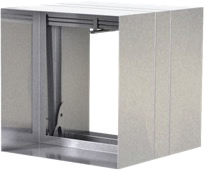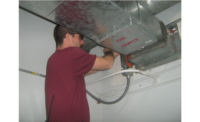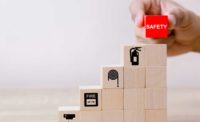Life-safety dampers are critical fire-protection features of buildings. By protecting duct and air-transfer-opening penetrations through fire- and smoke-rated construction, they help to contain fire and smoke within the area of origin. Like any mechanical device, life safety dampers need to be tested periodically to ensure they will work as designed when needed. Chapter 7 of the International Fire Code requires that fire dampers be maintained in accordance with NFPA 80, “Standard for Fire Doors and Other Opening Protectives,” and that smoke dampers be maintained in accordance with NFPA 105, “Standard for Smoke Door Assemblies and Other Opening Protectives.” The 2019 editions of NFPA 80 and NFPA 105 introduce important changes concerning the maintenance of fire and smoke dampers. This article explains those changes and how they can significantly reduce costs while making buildings safer.
NFPA 80 and NFPA 105
According to the 2016 editions of NFPA 80 and NFPA 105, during the commissioning of a new or remodeled building, life-safety dampers must undergo “acceptance testing” to confirm proper operation. The dampers then must undergo “periodic testing” to confirm continued operation. Periodic testing is required one year after dampers are installed and every four years thereafter, except in the case of hospitals, whereby testing is required one year after installation and every six years thereafter. Requirements regarding acceptance testing and frequency of periodic testing are unchanged in the 2019 editions of NFPA 80 and NFPA 105.
Also unchanged is the method for performing periodic testing of life safety dampers that utilize a fusible link. The fusible link must be removed to confirm a damper closes as designed. The fusible link is required to be removed, inspected, and replaced manually, meaning someone must physically go to the damper to perform the test.

Figure 1: Damper position-indication device with linkage connected directly to a damper blade.
The most significant change in the 2019 editions of NFPA 80 and NFPA 105 concerns the method for conducting periodic testing of life safety dampers that do not incorporate fusible links — namely, smoke dampers and most combination fire/smoke dampers and motorized fire dampers. The 2016 editions of NFPA 80 and NFPA 105 require visual confirmation of a damper’s ability to fully open and close. The 2019 editions of NFPA 80 and NFPA 105 retain visual inspection as an option while introducing the option of remote testing.
Three preconditions must be met before remote testing can be utilized:
- A damper must be capable of indicating (via factory-supplied position-indication device) when it is fully open and when it is fully closed.
- The initial remote test must include a visual inspection in accordance with NFPA 80 and NFPA 105. Often, this visual inspection takes place during acceptance testing.
- The visual inspection must confirm that the position-indication method used for remote testing accurately reflects the fully open and fully closed position of the damper.
Once these preconditions have been met, required periodic testing may be conducted remotely. The procedure is as follows:
- A signal from the damper’s position-indication device confirms the damper is in the normal operating position according to the system design (typically, the fully open position).
- The damper is commanded to the position opposite the normal operating position and the position-indication device confirms the damper has reached that position (typically, the fully closed position).
- The damper is commanded back to the normal operating position and the position-indication device confirms the damper has reached that position (typically, the fully open position).
If a remote test fails to comply with steps 1-3, a visual inspection is to be conducted.
Damper Position-Indication Devices
There are several ways to confirm that a life safety damper has reached its open and closed positions. One is to connect the position-indication device directly to a damper blade by way of linkage (Photo A). This often is referred to as positive blade indication. The damper blade moves the linkage as the actuator operates the damper. Once the damper reaches the open position, the linkage “trips” an electromechanical switch that is used by the building automation system, fire-alarm panel, or other system to confirm the damper is open. When electrical power — or, in the case of dampers with pneumatic actuators, air pressure — is removed from the actuator, the spring inside the actuator rotates the damper blades to the closed position, which again moves the linkage. Once the damper reaches the closed position, the linkage trips a second electromechanical switch used to confirm the damper is closed.
The use of position-indication devices is not new. They have been used in smoke control systems to confirm smoke and combination fire/smoke dampers are in the intended position for more than 25 years. In fact, Section 909 of the International Building Code requires dampers used as part of a smoke control system to have position-indication capability. Thus, remote damper tests can be performed in Section 909 smoke control systems with no requirement for additional hardware or system integration.
Concerns over Remote Testing
Concerns about the reliability of remote testing have been raised. First, it must be remembered that not all life safety dampers are candidates for remote testing. The most notable exceptions are curtain-style fire dampers (Photo B) and any damper utilizing a fusible link. NFPA 80 and NFPA 105 permit the remote-test method only for dampers not utilizing a fusible link. Thus, code-required periodic testing of dampers utilizing a fusible link still must be conducted using the visual-test method described in NFPA 80 and NFPA 105.
Concerns also have been raised over the fact that some position-indication methods may send a signal that a damper is closed when the blades are partially open. There are, however, commercially available position-indication methods designed to indicate only when a damper’s blades are completely closed. NFPA 80 and NFPA 105 enforce the use of these types of position-indication devices by requiring that the initial visual inspection, which is required as a precondition to utilizing the remote method, “confirm that the position indication method accurately reflects the full-open and full-closed position of the damper.”
Often, improper installation or tampering during building construction is to blame for poor life safety damper operation. Examples include dampers installed out of square, sheet metal screws installed in locations preventing damper linkages from fully operating a damper, the loosening of actuator clamps on damper shafts, and boards installed between damper blades to prop open a damper. Such problems should be identifiable during the visual inspection required by NFPA 80 and NFPA 105 at the time a building is commissioned, prior to remote testing. If the problems are not identified during the initial visual inspection or they occur afterward, a remote test will identify that the damper is not operating properly. That is because the remote-test method requires positive indication that both the open and closed positions have been reached. For example, if a sheet-metal screw is installed in a damper’s linkage, the damper may be able to close but not be able to fully open. The position-indication linkage connected to the damper blade, then, will not trip the electromechanical switch that confirms the open position, resulting in a failed test. Anytime a remote test cannot confirm a damper is able to reach its open or closed position, NFPA 80 and NFPA 105 require a visual inspection to be conducted.

Figure 2: A curtain-style fire damper.
Benefits of Remote Testing
There are several benefits to conducting life safety damper testing remotely. One concerns accessibility. While some life safety dampers cannot be accessed without the removal of permanent building features, the remote test method provides an option for periodically confirming such dampers are operating properly. Additionally, the remote test method eliminates the need to breach ceiling membranes for the conducting of tests. Opening ceilings has the potential to expose building occupants to airborne microbes that can lead to infectious disease. This especially is a concern in health-care facilities.
The remote-test method also dramatically reduces the cost and coordination associated with life safety damper inspection. Because remote tests can be conducted at little to no cost, they increase the likelihood and frequency of damper inspections, improving building safety.
Summary
The 2019 editions of NFPA 80 and NFPA 105 allow building owners to conduct code-required periodic testing of certain life-safety dampers remotely. Three preconditions must be met. Once they are, periodic testing can be conducted more cost-effectively and more frequently, leading to safer buildings.




